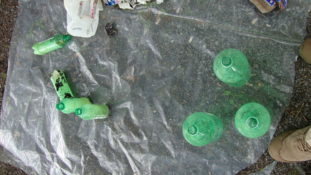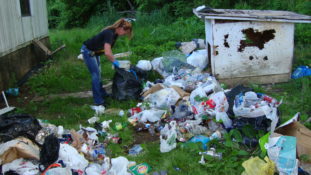There are a lot of myths surrounding meth production in our county. Most of it comes from the meth industry changing so quickly in the past few years, which I’ve written about before. As a result, we’ve ended up in a strange position where a lot of people know the conventional wisdom of the signs of a meth lab, but that conventional wisdom doesn’t really apply anymore. Sure, there’s still meth in Carter County, but it’s coming from Mexican cartels. It’s not usually being made here.
I wanted to write about a few of these meth lab myths we see a lot as investigators. We get a lot of calls from people who think their neighbors are cooking meth, and most of the time that’s not what’s going on. Hopefully busting a few of these myths gives you a little insight into what we see as law enforcement, and maybe makes you feel a little safer.
Meth Lab Myths

Meth Lab Myth 1: The labs smell like ammonia or strong chemicals
Truth: Most meth labs give off no odors. The one pot method of making methamphetamine was by far the most prevalent method we’ve seen in recent years, and it leaves no odor. So if you smell something acrid coming from your neighbor’s house, there’s a good chance it’s cat urine, not meth.
Meth Lab Myth 2: Meth cooks burn trash in the backyard
Truth: There are lots of people who don’t cook meth who burn their trash, so it’s not a good indicator for meth production on its own. If you notice people regularly burning trash in the middle of the night, and there are other indicators for meth production, then it may be a good sign that something illegal is happening. But by itself, burning trash can be normal.
Meth Lab Myth 3: Dealers and cooks have a lot of traffic to and from their houses at night
Truth: Most dealers try to sell meth away from home, so it’s harder for us to track them down. About 80 percent of our undercover buys take place somewhere other than the dealer’s residence. There are all kinds of reasons why there might be traffic to and from a house late at night. People there may be very social, or they may work irregular hours.
Meth Lab Myth 4: Houses that have trash all over the yard are meth labs
Truth: While most meth labs are trashy, that doesn’t mean everyone who has trash is cooking meth. Sometimes people have stuff that you may think is junk, but it has value to them. And some people are just messy, but we can’t usually do much about that.
How You Can Help

One thing to remember is that one clue alone is rarely enough to conclude that a house is hiding a meth lab. Investigators look for a combination of indicators to determine if a house is likely to have drug activity or not.
Our most helpful tips are the ones that give us lots of details. If you can give us a tip about drug activity and you have the address, times, names, or license plate numbers. License plate numbers are especially helpful, because we can run a background check that will give us a pretty good idea of whether there’s something illegal going on.
Details are the big difference makers between a tip that is reliable and one that isn’t reliable. A tip that gives us an address, some specific times that there’s suspicious activity, and a license plate makes it much easier for us to determine quickly if there’s something criminal to investigate or if it’s just a weird neighbor.
Keep in mind that we may investigate and find nothing. You may really dislike your neighbors, but that doesn’t always mean we can do something about that. On the other hand, we may determine that there is criminal activity taking place and begin an investigation. If that happens, there’s a good chance you won’t hear anything from us about it. We have to protect the investigation from any kind of possible compromise. So if you speak to us about some activity in your area and you don’t hear anything back about it, don’t assume we’re doing nothing. We’re working, we’re observing, we’re investigating. These types of investigations take a long time to finish. If you want to know why, check out my last blog post here.
One final thought for all of you. I know it’s really easy to look around and see all the meth use that happens in our region and think that everyone is doing meth. I’m sure we can all think of at least one family member or friend that’s messed up their life with drugs and addiction. Maybe you can think of several. But it’s important to keep perspective and remember that most of the people you know and love aren’t doing that. Meth users are only a small percent of the population; they’re not the majority.
Of course, meth is still a problem, and my colleagues and I are continuing to fight that problem, but the picture may not be as bleak as you think. We still serve thousands of amazing citizens who are making the right choices, and we have made some incredible progress stopping the people making the wrong choices. So even though there’s still meth around here, hopefully you won’t be seeing the Meth Phantom everywhere now.